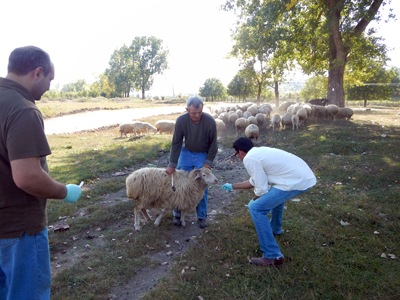CDC EIS Conference: Global Health Presentation Schedule
Front-line disease detectives present global health research investigation findings
Press Release
For immediate Release: Wednesday, April 30, 2014
Contact: Media Relations
(404) 639-3286

Neil Vora with sheep orthopox outbreak in Georgia (country).
The Centers for Disease Control and Prevention (CDC) today continued its 63rd Annual Epidemic Intelligence Service (EIS) Conference, which focuses on key health initiatives such as global health. This week-long event highlights the work of its current EIS officers or “disease detectives” and welcomes the incoming class of officers. Presentations describe recent and ongoing EIS investigations. More details about the global health presentations are available below.
In today’s interconnected world, a health threat anywhere is a health threat everywhere. Outbreaks can spread at the speed of an intercontinental flight. Global health security – keeping the U.S. and the world safe and secure from infectious disease threats – is achieved by preventing, detecting and responding to outbreaks as early and effectively as possible. Threats to global health security include new and re-emerging pathogens, increasing antibiotic resistance and intentionally created bioweapons. Through strategic investments in critical public health systems, CDC is working with other nations to increase their ability to prepare for and respond to public health threats and reduce the risk of these threats crossing borders.
“With today’s patterns of global travel and trade, disease can spread nearly anywhere within 24 hours,” said CDC Acting Chief, Epidemic Intelligence Service Dr. Diana Bensyl. “On average, CDC starts about one new investigation a day and identifies one new microbe each year. The CDC’s EIS program is an important part of our work to prevent, detect and respond to global health threats. We’ve made some exciting progress. However, there’s still a lot left to do to improve health security and respond more quickly to outbreaks.”
The conference presentations on global health include:
- Contact Investigation of Melioidosis Cases Reveal Regional Endemicity: Melioidosis results from infection through broken skin, ingestion, or inhalation of Burkholderia pseudomallei bacteria. Case-fatality rates can be as high as 40 percent. Improved survival rates are attributed to early diagnosis and treatment with appropriate antibiotics. Sporadic cases have been identified in Puerto Rico, where the incidence and epidemiology is unclear. An outbreak investigation led by Dr. Thomas J. Doker – including a painstaking door-to-door canvassing of neighborhoods linked to cases – suggests that the bacteria that causes melioidosis is well established in at least eastern Puerto Rico.
- First Chikungunya Outbreak in Micronesia: Chikungunya virus, transmitted to humans by mosquitos, can cause fever and severe joint pain. In October 2013, an outbreak of chikungunya virus disease was identified by CDC and Yap Department of Health among residents of Yap State, and marked the first documented local transmission of the virusin the Federated States of Micronesia. An outbreak investigation led by Dr. Daniel M. Pastula found a high disease attack rate and rapid geographic spreadof the virus. Lessons learned may be applicable to the current spread of chikungunya virus in the Caribbean islands.
- Two Cattle Herdsmen Infected with a Novel Species of Orthopoxvirus: Smallpox eradication meant the end of routine smallpox vaccination – and the end of cross-protection that smallpox vaccination provides against some other orthopoxviruses. With the exception of smallpox, orthopoxvirus infections are often associated with animals. When two herdsmen in the country of Georgia, both of whom were not vaccinated against smallpox, became ill after contact with sick cattle, CDC determined through extensive testing that they were infected with a previously unknown orthopoxvirus. Fortunately, they survived the infection. Dr. Neil Vora led the outbreak investigation that followed. The CDC team found evidence suggesting some of the herdsmen’s cows had previously been exposed to orthopoxviruses and that viruses also circulated among rodents in the area. The team diagnosed a third person with this virus who lived in a different part of the country and who was originally suspected of having anthrax. The findings suggest that this new virus might be a part of a trend of orthopoxvirus emergence in the absence of routine smallpox vaccination.
The FY 2015 President’s Budget requests funding for CDC’s Global Health Security activities to help accelerate progress in preventing the introduction and spread of global health threats.
The CDC has developed a digital press kit, filled with high resolution images, infographics, multimedia and quotes from experts on the EIS Conference. Media wishing to attend the EIS conference should RSVP to CDC Media Relations, media@cdc.gov or (404) 639-3286.
For more information about the Epidemic Intelligence Service conference:
http://www.cdc.gov/EIS/Conference.html
For more information about the CDC’s Epidemic Intelligence Service:
http://www.cdc.gov/EIS/More.html
